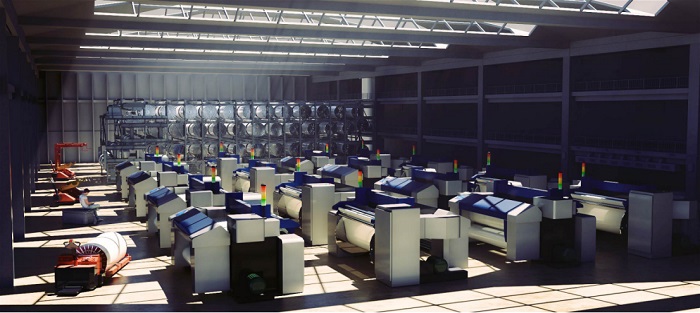In 2020, due to the promotion of the demand for epidemic prevention materials, the global industrial textile industry has experienced a round of rapid growth, which has accumulated a large base for the development of the industry in 2021; at the same time, as the global epidemic situation changes, the demand for epidemic prevention materials has increased significantly. Decline, the growth rate of masks, protective clothing and related raw and auxiliary materials industries will see a sharp correction in 2021, driving the decline in the growth rate of the main economic indicators of the entire industry.
From January to May of 2021, the industrial added value of enterprises above designated size in the industrial textile industry fell by 11.9% year-on-year, with an average increase of 15.2% in two years; the output of non-woven fabrics of enterprises above designated size reached 2.449 million tons, an increase of 9.2% year-on-year. The output was 327,000 tons, a year-on-year increase of 32.3%; the operating income of enterprises above designated size reached 117.51 billion yuan, a year-on-year increase of 0.3%, and the total profit realized was 7.02 billion yuan, a year-on-year decrease of 54.5%. The profit rate was 6.0%, a year-on-year decrease of 7.2 percentage points.
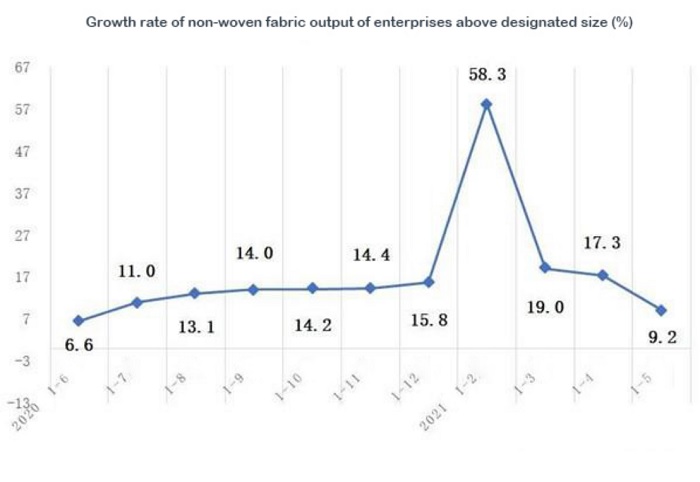
In terms of sectors, the operating income and total profits of nonwovens enterprises above designated size from January to May decreased by 7.7% and 67.8% year-on-year, respectively, and the profit margin was 6.2%, a year-on-year decrease of 11.5 percentage points; Operating income and total profit increased by 24.6% and 43.6% respectively year-on-year, and the profit rate was 4.2%, an increase of 0.6% year-on-year; the operating income and total profits of enterprises above designated size for textile belts and cord fabrics increased by 28.2% and 198.0% year-on-year, respectively. The rate was 5.7%, an increase of 3.3% year-on-year; the operating income and total profits of enterprises above designated size for awnings and canvas increased by 37.4% and 63.3% year-on-year, respectively, and the profit rate was 6.2%, an increase of 1.0% year-on-year; The operating income and total profits of other industrial textile enterprises above designated size where textiles are located decreased by 10.3% and 53.5% year-on-year, respectively, and the profit rate was 6.0%, a year-on-year decrease of 5.6 percentage points.
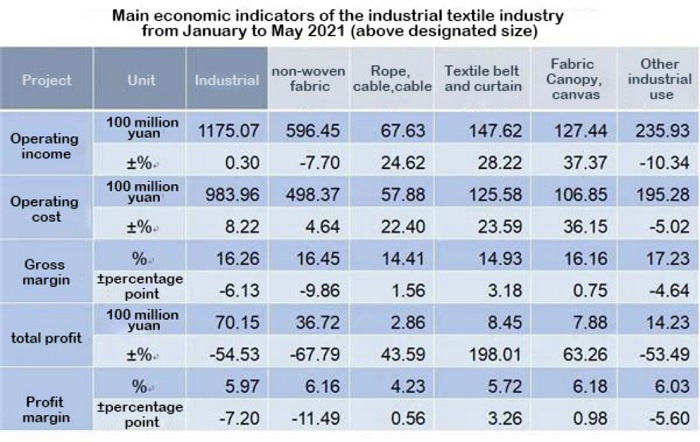
In terms of international trade, from the perspective of major export products, exports of non-woven fabrics, special yarns, threads, ropes, cables, cables and their products (products in Chapter 56 of the Comprehensive Customs Classification of Commodities) valued at US$3.52 billion from January to May, year-on-year An increase of 46.4%, of which the export of non-woven fabrics was US$2.04 billion, a year-on-year increase of 54.9%, and the export volume was 627,000 tons, a year-on-year increase of 52.2%. An increase of 38.0%. In terms of the export of anti-epidemic materials, the export of chemical fiber nonwoven protective clothing (including medical protective clothing) was US$1.43 billion, a year-on-year decrease of 34.5%; the export of unlisted textile products (including masks) was US$6.01 billion, a year-on-year decrease of 75.1%.
At present, with the continuous improvement of vaccination rate and the recovery of global market demand, the fields of anti-epidemic materials and non-epidemic materials in the industrial textile industry are showing two completely different development trends. The development of anti-epidemic materials related fields in the industry has gradually returned to the level before the epidemic. The profitability of these fields has continued to decline sharply from January to May, but the average growth rate of the total profit of non-woven fabrics enterprises in two years has reached 24.6%; the non-epidemic materials sector has continued the recovery trend, most of which have recovered or even better than the pre-epidemic level, but the rise in the cost of raw materials, labor, freight and other factors puts the recovery in these areas under greater pressure. It is expected that in the remaining months of this year, the total profit of the industrial textile industry will continue to decline compared with the same period last year, but the profit rate will be better than the level before the epidemic.
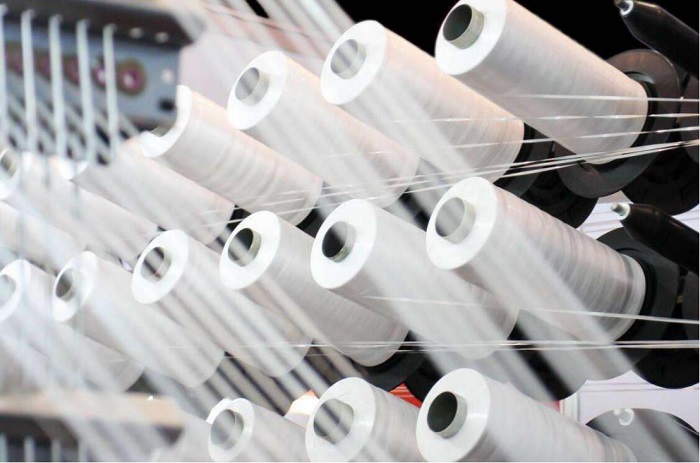
Problems in the development of the textile industry
It can be seen that the overall prospects of the weaving industry are improving, and the industry is also developing rapidly, but the profit margin is low, mainly because of the high cost, including labor costs, raw material costs, equipment purchase and operating costs, and various costs have risen across the board. , And finally transferred to the product terminal, which brought various rises in yarns, grey cloths and fabrics. Among them, the main reason is that labor costs are rising year by year.
In 2020, the average annual salary of employees in urban non-private units was 97,379 yuan, an increase of 7.6% over the previous year, and the actual increase was 5.2% after deducting price factors; the average annual salary of employees in urban private units was 57,727 yuan, an increase of 7.7% over the previous year, deducted The price factor actually increased by 5.3%. Although the growth rate has slowed down compared with previous years, the average annual salary of employed persons in urban units has continued to increase.
A textile industry analyst said that labor costs in the textile industry are still high in other industries. Many companies said that the current labor cost has risen from 20%-30% of the total cost a few years ago to 50%-60%. At present, there is still no stopping the upward trend.
With the current shift in employment trends, many young people are unwilling to go to workshops and factories in traditional manufacturing industries. In addition, the textile industry's own noise, pollution, temperature and other conditions, indeed fewer and fewer talents are willing to stay in textile production enterprises. Textile companies are faced with the problems of difficulty in recruiting and expensive labor. In order to retain workers, they have to raise wages year by year.
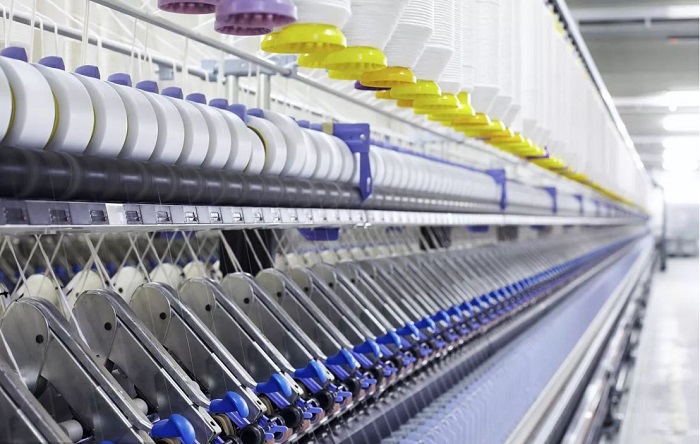
How to reduce labor costs?
Textile companies may be able to improve production efficiency and reduce labor costs through intelligent means. It can improve the mechanical automation level of the textile industry production equipment, realize the automatic production of the assembly line, intelligent management, storage handling, and reduce the assembly line workers, storage handling and management costs.
The replacement of some labor by machines will be the general trend of the textile industry as a whole. The successful manufacturing industry in the future must be enterprises that make good use of smart technology. In fact, all aspects of the textile industry's operations can reduce labor burden and improve efficiency through machines.
Suntech is based on the current pain points of the industry to make a comprehensive solution, professionally provide intelligent machinery, involving all aspects of the textile industry, including the intelligent rapier loom, double-folding seaming machine, cloth guide, etc. that need to be used in textile production. Cloth turning machine, cloth cutting machine, cloth loosening machine, cloth inspection machine used in textile finishing, packaging inspection production line, packaging machine, stacker, etc., as well as electric axle carts and beam stacker , AGV, robots, intelligent three-dimensional warehouses required for textile storage and transportation, etc.
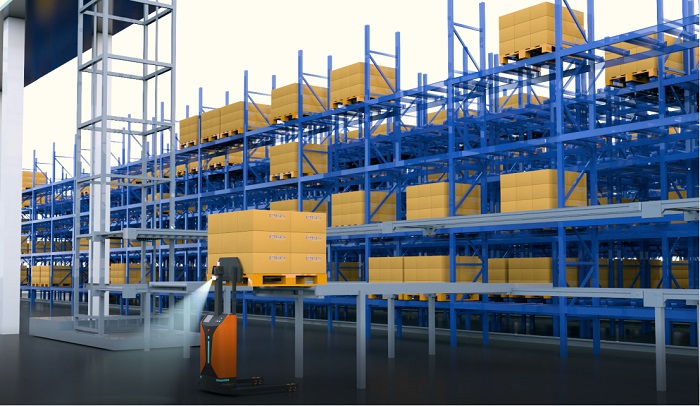
It has also been suggested that the replacement of machines is extremely fast, and the cost of a machine is relatively high. If automation is promoted, productivity can increase by 10%-20%, and the profit point can be maintained at about 10% under the condition of the original number of workers. But if you use an old machine, the above effect will not be achieved.
Suntech has prepared a response to this, including strengthening management, improving equipment performance, and improving efficiency per unit time. In addition, increase outsourcing, outsourcing those with low added value, let others bear the labor management cost, and concentrate on maintaining good customers. The other is to strengthen development and increase the added value of products.
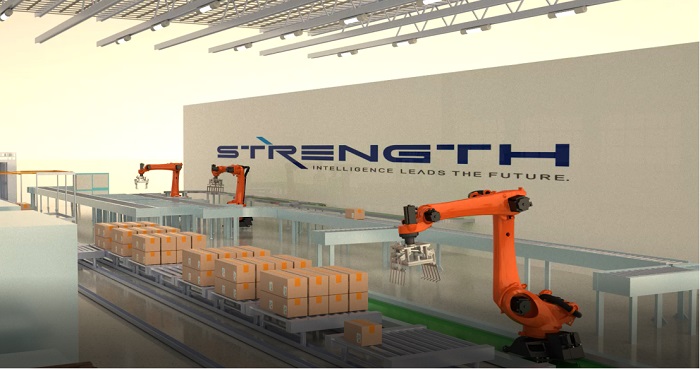
Rapier loom
The rapier loom is currently the most widely used shuttleless loom. In addition to the characteristics of high-speed, high-automation, and high-efficiency production of the shuttleless loom, its active weft insertion method has strong variety adaptability and can adapt to The weft insertion of various yarns and rapier looms also have obvious advantages in multi-color weft weaving, which can produce yarn-dyed products with up to 16 colors of weft yarns. As shuttleless looms replace shuttle looms, rapier looms will become the main type of woven fabric production.
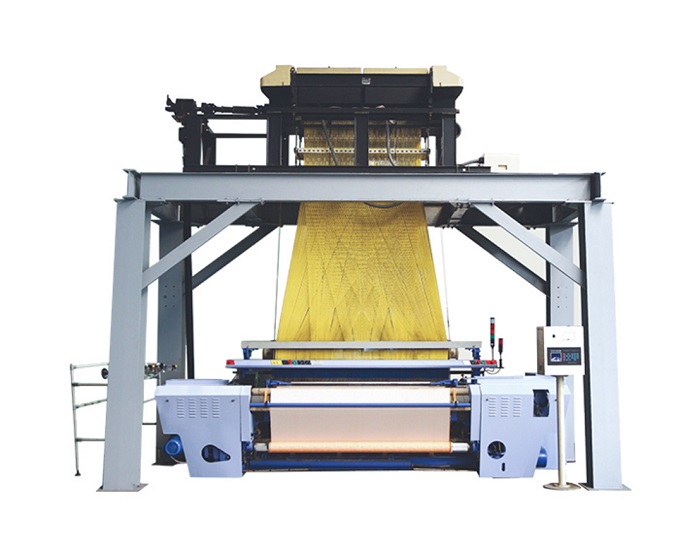
With 50 years of technical precipitation and design experience, the old-brand machinery company Suntech has developed and designed rapier looms that not only intelligently integrate the five basic steps of weaving, but also the finished cloth can directly enter the automatic cloth inspection link, saving a lot of manpower and material resources Time and cost. Has the following functional highlights.
1. Automatic inspection (fabric)
(1) The loom is equipped with LED lights and smart cameras, and an automatic fabric inspection link is set up so that the fabric can be intelligently tested after weaving is completed, so that defects can be found in time and unqualified woven fabrics can be eliminated.
(2) Replace manual inspection cloth with intelligent test cloth, which is efficient and low error rate.
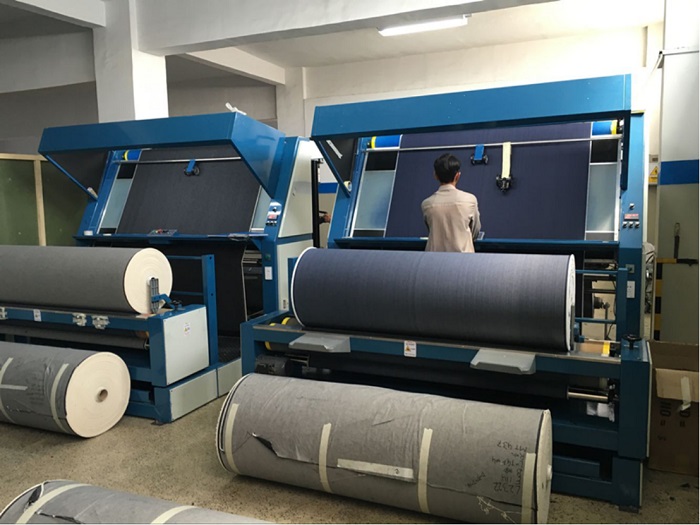
2. Automatic weft insertion
(1) The flexible rapier is used for weft insertion, and the central transfer is used to introduce the weft yarn into the shed formed by the warp yarn so as to interweave with the weft yarn. The formation of the fabric weft insertion must cooperate with the warp yarn opening.
(2) Driven by a spatial four-bar linkage mechanism, no guide hook, floating single guide hook, double guide hook weft insertion.
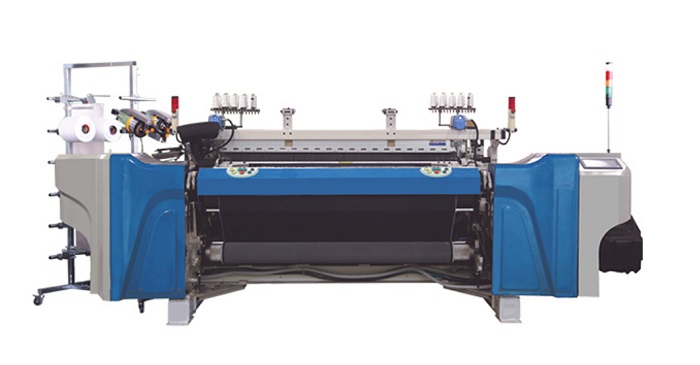
3. Servo electronic let-off
(1) Adopt the outside type automatic warp let-off device, the weaving shaft detection device automatically adjusts the weaving shaft rotation angle through the linkage mechanism, and sends out a certain amount of warp yarn with a certain tension during the weaving process to maintain the continuous weaving process and ensure the weaving shaft during the weaving process. Can maintain a uniform warp tension from large to small
(2) The structure is simple and the adjustment is convenient. There is no need to make any adjustments when changing from a full beam to an empty beam or loading a new warp beam. The warp beam capacity is 800mm or $1000mm.
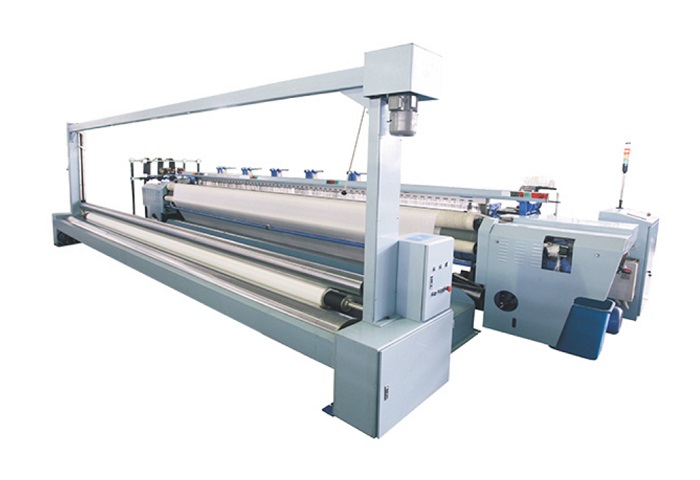
4. Electronic take-up
(1) The fabric initially formed at the weaving mouth is taken away from the weaving mouth and wound on the cloth roller, and at the same time, it cooperates with other mechanisms on the loom to determine the weft arrangement density of the fabric and the arrangement characteristics of the weft yarn in the fabric.
(2) Worm-wheel-type intermittent coiling. The swing seat installed on the sley foot drives the connecting rod and supporting teeth, and then the licker roller is driven by the worm gear to achieve coiling.
(3) Servo electronic winding, weft density range: 1-150 picks/cm.
(4) The center of the machine is wound, and the diameter of the cloth is 600mm. Or friction type winding outside the machine, the maximum roll diameter is 1200mm.
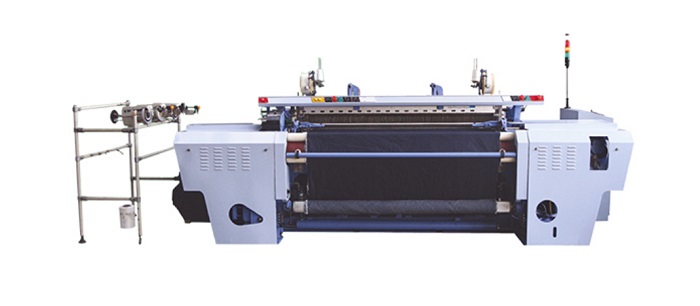
Customers who have used Suntech rapier looms are full of praise for this loom, which can be called artificial intelligence in the loom industry. According to statistics, this loom can save 50% of labor costs and 50% on average, and increase production by 50%. Efficiency, in addition to automatic cloth inspection, PLC automatic control, automatic weft search, servo electronic warp let-off, and servo electronic take-up are also available, making every step of the textile intelligent and greatly increasing the production speed.
One machine can replace two or more skilled workers, and the efficiency is greatly increased. The original production requires one day, but now it may only take half an hour. The machine does not need to pay social security, and does not need "dismissal compensation", which greatly reduces labor costs. It is expected that the rapier loom can save hundreds of thousands of labor costs for customers a year. Welcome to inquire in detail.
